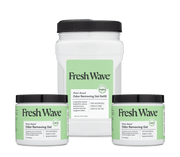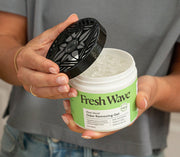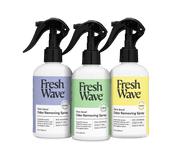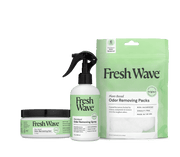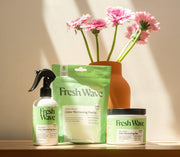Recently, volatile organic compounds or VOCs were in the news when a study concluded that more than 5,000 tons of these harmful airborne compounds were released just in the state of California in 2020. Fresh Wave products are 100% free of VOCs and as part of our commitment to cutting down on the number of VOCs in the air, we put together this guide to answer common questions like “What are VOCs?” and “What health effects do VOCs cause?”
What Are Volatile Organic Compounds (VOCs)?
Volatile organic compounds or VOCs are compounds that are highly soluble and have a high vapor pressure. As a result, these gases can be emitted from solids and liquids. When they take on gaseous form, they enter the air we breathe and can settle onto surfaces throughout your home. Common VOCs include acetone, formaldehyde, benzene, ethanol, TCE and naphthalene.
Chemicals used in industrial applications are a major source of VOCs, but they are also present in many everyday objects found in homes and offices, including cleaning products, paints, paint strippers, lawn and garden pesticides, building materials, furniture, copiers, printers, glues and adhesives and permanent markers.
The EPA reports that VOC levels may be as much as 200 to 500% higher in homes than outdoors. Research conducted by the EPA has also found that volatile organic compounds can linger in the air for long periods of time after you use a product that contains them.
Health Effects of VOCs
VOCs can cause both short and long-term health effects. Exposure to them can result in:
- Irritation of the nose, eyes and throat
- Dizziness
- Headaches
- Nosebleeds
- Nausea
- Fatigue
- Skin rashes
Exposure to high levels of VOCs or repeated exposure to small amounts of VOCs may cause:
- Liver damage
- Nervous system damage
- Kidney damage
- Vision problems
- Memory problems
Young children and older adults may be more susceptible to the adverse effects of VOCs. The compounds can also worsen symptoms of asthma and chronic respiratory conditions.
Identifying and Measuring VOCs
Now that you know the answer to the question “What is a VOC?” you’re likely wondering why they’re allowed to be in products and whether they are present in your home. Unfortunately, the EPA doesn’t have the ability to regulate indoor air quality, and most states don’t have laws that regulate the presence of VOCs in products. And although VOCs can give off strong odors, the compounds can be odorless in some cases. They’re also colorless, so it’s difficult to detect them with the naked eye.
Home test kits are available for checking VOC levels, but the accuracy and reliability of these tests has yet to be established. As a result, the best way to determine if you have VOCs in your home is to hire a professional air quality testing service that is well established and has good online reviews. You can also check the labels on products in your home to look for items that may contain VOCs.
Minimizing VOC Exposure
Although you may find it difficult to determine the exact level of VOCs in your home, you can take positive steps to reduce your exposure regardless of how many VOCs are present. Some things that can help include:
- Reading labels carefully: When you need to purchase something that commonly contains VOCs like cleaning products or paint, read the label information. There are low-VOC and VOC-free alternatives for many products available on the market, so do your research and choose ones that will have less of an impact on indoor air quality.
- Ventilating your home: Proper ventilation can reduce the risk of VOCs lingering in the air. Use fans to improve air circulation in stuffy areas of your home. Run your air conditioner in the summer, and keep your heating and cooling system well maintained. You may also want to purchase an air purifier that is effective against VOCs.
- Cleaning regularly: As previously mentioned, VOCs can collect on surfaces throughout your home. Regularly vacuuming, wiping down surfaces with a wet cloth and cleaning upholstery, carpeting and drapes can help to remove VOC residues.
Natural Odor Removal Solutions for VOCs
It’s a common misconception that all air fresheners contain VOCs. While it’s true that many products designed to eliminate household odors do contain chemicals capable of giving off volatile organic compounds, there are VOC-free alternatives available. Products that contain man-made synthetic chemical fragrances are more likely to give off VOCs than ones derived from natural sources like plants.
Some odor-removing products can actually aid in your efforts to reduce VOC levels in your home. Fresh Wave products are an example. Our sprays, gels and other products feature Fresh Air Technology, which comes out of 30 years of research. The natural blend of VOC-free plant oils in our products attract odor molecules, including some VOCs. Once they encounter them, they attach to the molecules and surround them. Then, a chemical reaction occurs, neutralizing the reactive compounds. Not only does this eliminate unpleasant smells in the kitchen, bathroom and beyond, but it also may lessen the number of VOCs in the air.
Take Steps to Address Vocs in Your Home
VOCs are found in many common household products, but that doesn’t mean that you can’t take steps to minimize your exposure to them. Keeping your home clean and well maintained, ensuring that your house has proper ventilation and switching to low-VOC and VOC-free products can all make an impact. Fresh Wave products can be part of the solution. Our line of odor-eliminating products contains plant-derived, nontoxic ingredients with absolutely no VOCs. Discover all the ways you can freshen your home without compromising indoor air quality by shopping our line of odor-eliminating products today.


